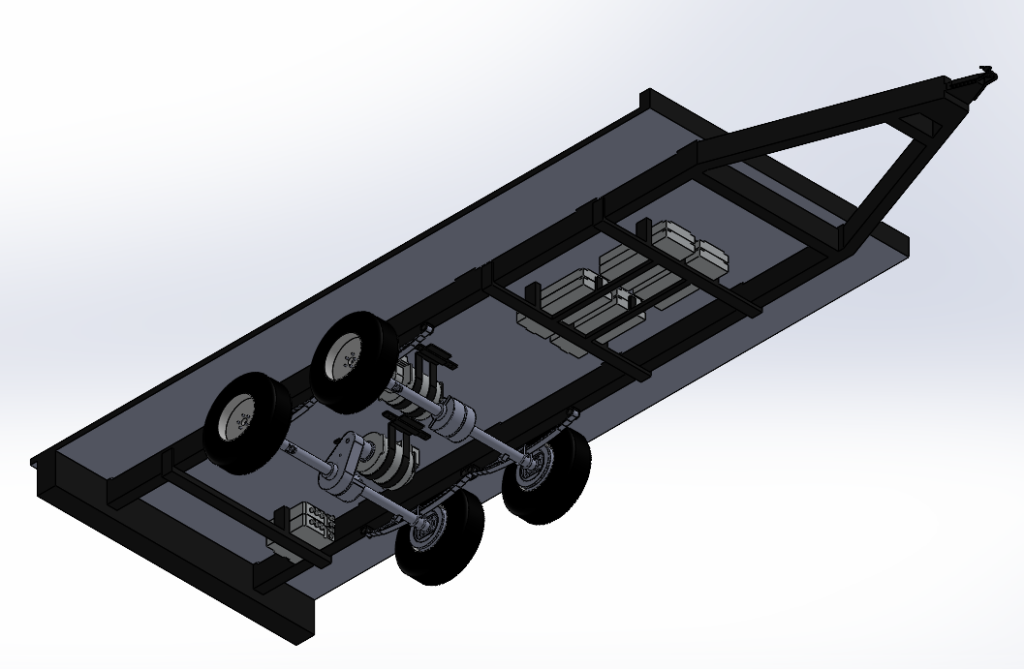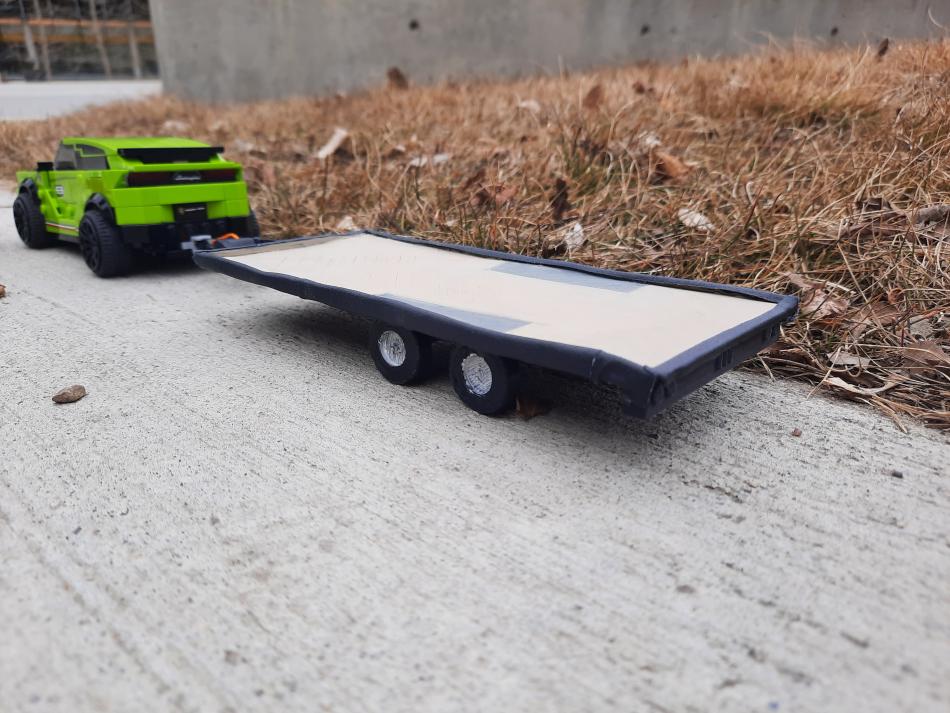Project Category: Multidisciplinary
Join our presentation
About our project
Trailers have traditionally followed a very simplistic design that serves only one main goal, that is to haul its respective payload to its final destination in a safe manner. In the last decade demand to haul heavier payloads has been increasing, with the main factor allowing this being higher output, and more robust drivetrains in tow vehicles. However with auto manufacturers on both the personal and commercial scale being pressed to produce more efficient lower emission solutions this bears a negative impact on towing capabilities. Additionally with the rise in popularity in electric vehicles, and soon to follow the electrification of commercial fleets, further concerns are imposed due to EV’s poor towing performance specifically how it affects driving range.
This relatively new problem is what dictated our design goal. We set out to design a trailer that contains its own independent electric drivetrain via an electric motor mounted to its axle. Additionally this design would house its own onboard battery sized appropriately to achieve desired range when the trailer is loaded to its full GVWR (gross vehicle weight rating). Due to the complexity of this problem we began development on a small utility trailer and our final design settled on a deck-over style equipment trailer with a GVWR of 9990 lbs. All of the parts used in the design are considered “off the shelf” which was done for simplicity also meaning the average person could go out and build this themselves by retrofitting the parts to an existing trailer.
Meet our team members

Bryan Mascarenhas
Energy Engineering

Joshua Wong
Mechanical Engineering

Matthew Derouin
Energy Engineering

Shawn Servinski
Energy Engineering
Details about our design
HOW OUR DESIGN ADDRESSES PRACTICAL ISSUES
One of the most difficult parts about trailering is accelerating. This is something that can be witnessed in day to day life watching how long it takes transport trucks to accelerate from a stop, or even maintain speed up a steep ascent. It takes a lot of energy to move mass and traditionally when manufacturers have tried solving this problem it results in engine development to produce higher horsepower and torque figures, coupled with gearing. However in the modern day where legislation and mandates are pushing auto manufacturers to improve fuel efficiency, and reduce GHG emissions this creates a problem with trailering. Due to this there is a void in which our design has the potential to fill.
Our design in theory could reduce the need for high output engines while still maintaining good quality towing conditions, or from what we have found actually make significant improvements to towing dynamics.
WHAT MAKES OUR DESIGN INNOVATIVE
We consider our design to be very innovative, as a matter of fact there is only one similar product on market being the Airstream eStream Trailer concept (Gonderman, M). Whats also interesting about this product is that it is still a concept, and being a camper style trailer, however it wasn’t announced until a few months after we began the preliminary work on our project in the fall of 2021. Apart from this the electrically driven trailer is a virgin technology that isn’t seen or talked about anywhere.
Our design also boasts much higher performance than the likes of the Airstream eStream Trailer. Our trailer can fully accelerate the trailer (without help from the tow vehicle) at its heaviest possible configuration. Unlike the eStream which only provides a small amount of assistance to the tow vehicle.
To add to this trailers over the past few decades have really not seen a significant advancement or idea such as ours as trailers tend to be viewed as a tool that doesn’t need to be changed. This is true as trailers do their job as intended but with times changing this leaves space to make ground breaking advancements to benefit users.
WHAT MAKES OUR DESIGN SOLUTION EFFECTIVE
The main aspect that makes our solution effective is its simplicity. As previously mentioned trailers have always followed a very simple yet practical design and if ours did not do the same it would have no way of competing. We made use of off the shelf components that are manufactured by reputable companies who have been involved in their respective practice leading the way for years. We focused on not over complicating the design and using a minimal amount of parts to achieve our goal. For example many of the drivetrain components came from Dana Electrified, specifically our axle housings, electric motors, and their inverters. This guarantees that the components are seamlessly integrated and they can operate in harmony. Although there is a lot going on behind the scenes the design is quite straightforward itself.
For more information on the design itself please reference the video link on this page (above).
HOW WE VALIDATED OUR DESIGN SOLUTION
We found our design very difficult to validate given its complexity and lack of existing application. Numerous times throughout the project we found ourselves, and professionals that we consulted being stumped. Despite this we worked through many iterations to work out bugs or kinks in the design and at the end we yielded a design that we are confident in. It was also verified by professionals that specialize in the operation of electric vehicles which follow a very similar premise, as well as the knowledge we learned from classes. Some of the companies which we chose to use parts from in our design also gave us some verification that indeed what we are targeting, from a mechanical perspective is realistic.
FEASIBILITY OF OUR DESIGN SOLUTION
To determine the feasibility of our design we selected three criteria that must be satisfied. Firstly the trailer must perform as intended, meaning that the electric motors we selected are capable of accelerating the trailer at its GVWR of 9990 lbs and the battery must support sufficient range. Secondly we must do so by adding minimal weight to the trailer itself. If we add too much weight then we will increase the base weight of the trailer however this cuts into payload capacity which is the main function of the trailer. Thirdly the additional cost must be kept to a reasonable amount and be accurate to the worth of the designs capabilities.
With the off the shelf parts we selected being the Dana Spicer es4500r electric axles and TM4 Sumo LD HV800 electric motors we were easily able to meet the performance criteria. With our design being able to output a peak power of 335 hp per motor. Two of these electric motors were used and are able to accelerate our near 10000 lb trailer from 0-100 kph in around 6.5 seconds. Comparing this to our selected model tow vehicle a 2021 Ford F-150 equipped with the 3.5 L EcoBoost V6 which does 0-100 kph in roughly 6 seconds flat we can deem that our design met its criteria. Paired with refurbished Tesla batteries connected in series to comprise a 45 kWh battery this capacity allows our design to complete this acceleration roughly 50 times.
We were able to keep our additional weight relatively low and this can mainly be attributed to not needing a large battery pack. In total the batteries added roughly 200 kg of weight and the electric axle swap with their motors added 248 kg. Adding on other miscellaneous components totals 584 kg (1287 lbs) of total added weight. Taking the GVWR of the trailer and subtracting the base trailer weight as well as the weight we added this leaves 5951 lbs of payload capacity which is a 15% reduction to the standard trailers payload without our additions. We consider 15% to be a reasonable value and a sufficient amount of payload is still available for usage.
Due to different price quotes on the parts we used a low and high end estimate of cost was made. The low and high estimate were $26,900 and $43,700 (CAD), respectively on top of the base trailers cost. Given that the cost of our base PJ Trailers Medium Duty Deckover 6″ Channel (L6) trailer is roughly $9,500 we see a price increase in the range of 2.8-4.6x the base trailer.
We are very happy with the mechanical design of our trailer and we can deem it feasible. However assessing our design from a practical perspective the large increase in cost we believe doesn’t make our design feasible. Since our initial design on a smaller utility trailer we noticed significant improvements to our design criteria moving up to larger trailers being able to support more weight as well as increased price tags. This does in our opinion imply that the basis of our design is on the verge of feasibility if it were to be scaled to a commercial scale. More specifically tractor trailers costing upwards of $75,000 with GVWR’s of over 100,000 lbs, used to transport cargo. However currently parts supply would not make this possible as parts of this scale do not currently exist on market.
Partners and mentors
We want to thank the many people who helped us with this project. Our project sponsor Darcy Funk with Funk Energy Services who proposed the idea and gave us the freedom to develop it with great guidance. We would also like to thank our academic advisor Dr. Yani Jazayeri for guidance and feedback throughout the project. And, the help of Dr. Arief Budiman and Mohsen Hassani along the course of the project.
Our photo gallery
SolidWorks Model




3-D Printed Model







References
- Gonderman, M. (2022, January 25th). All-Electric, Powered Airstream eStream Trailer Can Assist Its Tow Vehicle. Retrieved from MotorTrend: https://www.motortrend.com/news/airstream-estream-electric-drivetrain-trailer/
